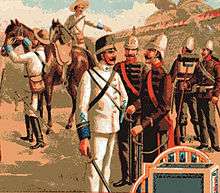Battle of the Cunene
In the Battle of the Cunene River, Portuguese Colonial forces were defeated by Angolan Ovambo warriors on 25 September 1904. The defeat was one of the heaviest defeats in Portuguese Colonial history since Alcácer Quibir (1578) and is comparable to the British defeat at Isandhlwana against the Zulus (1879), the Italian defeats at Dogali (1887) and at Adwa (1896) against the Ethiopians or the Spanish defeats at Melilla (1909) and at Annual (1921) against the Rif.

.jpg)
After having subdued the Nkhumbi people, Portuguese troops advanced from Huila southward into territories which were just claimed by Portugal but not yet under control. At Cunene River they were confronted with the resistance of two Ovambo peoples, the Cuamato and Cuanhama, led by their king Tchetekelo. When an advanced unit composed of 500 Portuguese soldiers and Humbi auxiliaries under captain Luís Pinto de Almeida crossed the river, about 300 men were massacred in an ambush.[1]
The Portuguese defeat was followed by a punitive expedition in 1905 and 1907,[2] but not before 1916 Southern Angola was "pacified".
Notes
- "Thus in September 1904 a Portuguese column lost over 300 men killed, including 114 Europeans, in an encounter with the Kunahamas on the Kunene, not far from the German frontier. ... In 1905 and again in 1907 there was renewed fighting in the same region" (Chisholm 1911, p. 40)
- Chisholm 1911, p. 40.
Sources
- Chisholm, Hugh, ed. (1911). . Encyclopædia Britannica. 2 (11th ed.). Cambridge University Press. p. 40.
- António Aniceto Monteiro: The Conquest of Southern Angola (The Massacre, 25 September 1904)
- José Bento Duarte: Desastre do Vau do Pembe (Angola) – 25 de Setembro de 1904